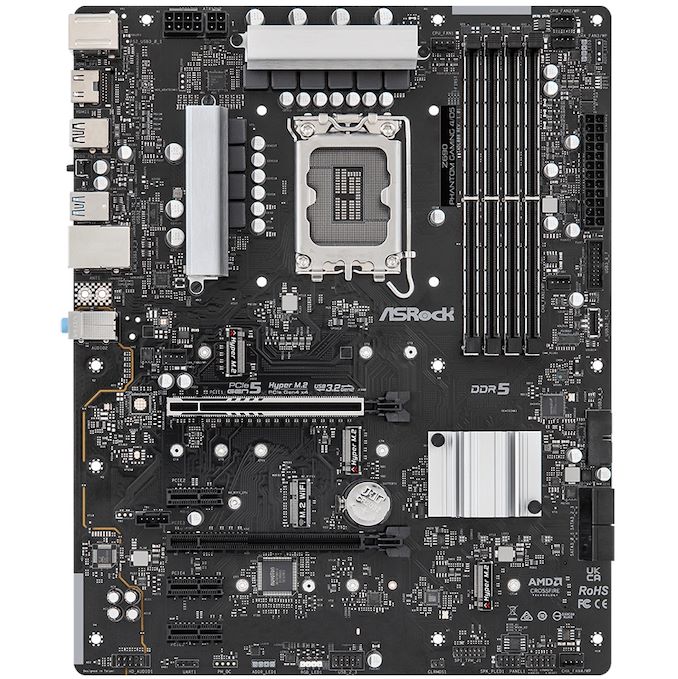The Intel Z690 Motherboard Overview (DDR5): Over 50+ New Models
by Gavin Bonshor on November 9, 2021 9:00 AM ESTASRock Z690 Phantom Gaming 4/D5
One of ASRock's more modest and entry-level gaming-focused Z690 models comes via the Z690 Phantom Gaming 4/D5, with the D5 signifying this model supports DDR5 memory and not DDR4. Equipped with an entry-level feature set, and an equally entry-level price point to boot, the ASRock Z690 Phantom Gaming 4/D5 has one of the more basic looks of all its Z690 models. It uses a primarily black theme with simple silver heatsinks throughout. It's also one of the most bare looking PCBs from all of the Z690 models at launch, with a real focus on cutting costs for users looking for an affordable model.
Looking at the board's specifications, there are two full-length PCIe slots, with one full-length PCIe 5.0 x16 slot, one full-length PCIe 4.0 x4 slot, and three smaller PCIe 3.0 x1 slots. Located in the top right-hand corner is the board's memory slots, with four in total offering support for DDR5-5800, and a combined total of 128 GB. Storage options are relatively basic as expected for a board of this pedigree, with three PCIe 4.0 x4 M.2 slots, with one of these also supporting SATA-based drives. The ASRock Z690 Phantom Gaming 4/D5 also includes just four SATA ports with support for RAID 0, 1, 5, and 10 arrays.
On the rear panel is a modest selection of input and output, including one USB 3.2 G2 Type-C, one USB 3.2 G2 Type-A, four USB 3.2 G1 Type-A, and two USB 2.0 ports. An Intel I219-V Gigabit Ethernet controller is the board's only source of networking support, while a Realtek ALC897 powers three 3.5 mm audio jacks. Finishing off the rear panel is a single HDMI port, with a small BIOS Flashback button and a PS/2 combo port for users preferring to use legacy peripherals.












126 Comments
View All Comments
DanNeely - Tuesday, November 9, 2021 - link
Good point. I thought Intel was pushing hard for 12vo with the 6xx series, but it seems to be completely MIA.Silver5urfer - Tuesday, November 9, 2021 - link
Can I ask why ? What does ATX12VO provide to a consumer ?It doesn't make your mobo cheap, it doesn't make your mobo less complicated, it does not make your system run cooler, it doesn't make ADL consume less power, It doesn't even make any sense.
ATX12VO was created because of that trash policies set by policing state of California about some nonsensical rubbish. Servers and Data centers can get away with modular high density PSUs because of fully standardized set and they also get 3M liquid cooling. This is consumer market and here we have people wishing for backwards in technology.
meacupla - Thursday, November 11, 2021 - link
A lot of people had the same sentiment about EU RoHS restrictions, and yet, it was implemented worldwide.With that attitude, the same can be said about energy star, and 80plus certifications. It adds cost to the product, yet it offers not a thing to the consumer.
Not everything is about you.
We need to do everything we can to cut down power consumption, and ATX12VO standardization across the entire industry is very low hanging fruit.
Stop being so selfish, there's literally only one habitable planet we have right now.
Oxford Guy - Thursday, November 11, 2021 - link
80 Plus offered plenty to consumers. Less power use means quieter PSUs.The knock on 80 Plus was unrealistically easy testing. Despite that, it helped raise the efficiency of PSUs. Along with better efficiency, ripple, holdout time, voltage consistency, and other factors improved — as enthusiasts began to pay more attention to PSU quality.
I don’t doubt that 80 Plus also helped a lot of non-enthusiasts/amateurs by keeping them away from ultra-cheap PSUs that catch fire. Having a high-profile certification that those PSUs can’t reach helped to steer those customers away.
yacoub35 - Tuesday, November 9, 2021 - link
That white metal trim running tight around the molex power connector on the ASUS ROG Maximus Z690 Formula must make it an absolutely nightmare to plug/unplug the main power cable to the board.Ranguvar - Tuesday, November 9, 2021 - link
Correction:"Previously with 11th gen (Rocket Lake), Intel upheaved it from a PCIe 3.0 x4 uplink on Z490 to a PCIe 3.0 x4 uplink on Z590."
This should say "to a PCIe 3.0 x8 uplink on Z590".
OFelix - Tuesday, November 9, 2021 - link
Correct. And whilst we are correcting that sentence - "upheaved" ????This first page really needs to be read by an AnandTech editor.
What's that? They don't any editors? :-(
OFelix - Tuesday, November 9, 2021 - link
"Z490 Motherboard Audio" ... presumably Z690?mode_13h - Friday, November 12, 2021 - link
I caught that, as well. Even the word "upheaved" is itself somewhat noteworthy. Plenty of better alternatives: "upgraded", "widened", "expanded", "increased", "enlarged", etc.GeoffreyA - Saturday, November 13, 2021 - link
While "upheaved" is likely an error, it's not far off from the words of today. Unfortunately, the English language is on a downgrade, and it's just going to get worse and worse. The language's genius is not tuned to the over-economical forms we're finding today; and a lot of it seems to be coming from tech. Upthis, upthat. My favourite, though, is leverage. A big, scary word that companies are fond of, and which escaped its programming, game development roots. Soon, we'll be leveraging the kettle to make tea. How about using?